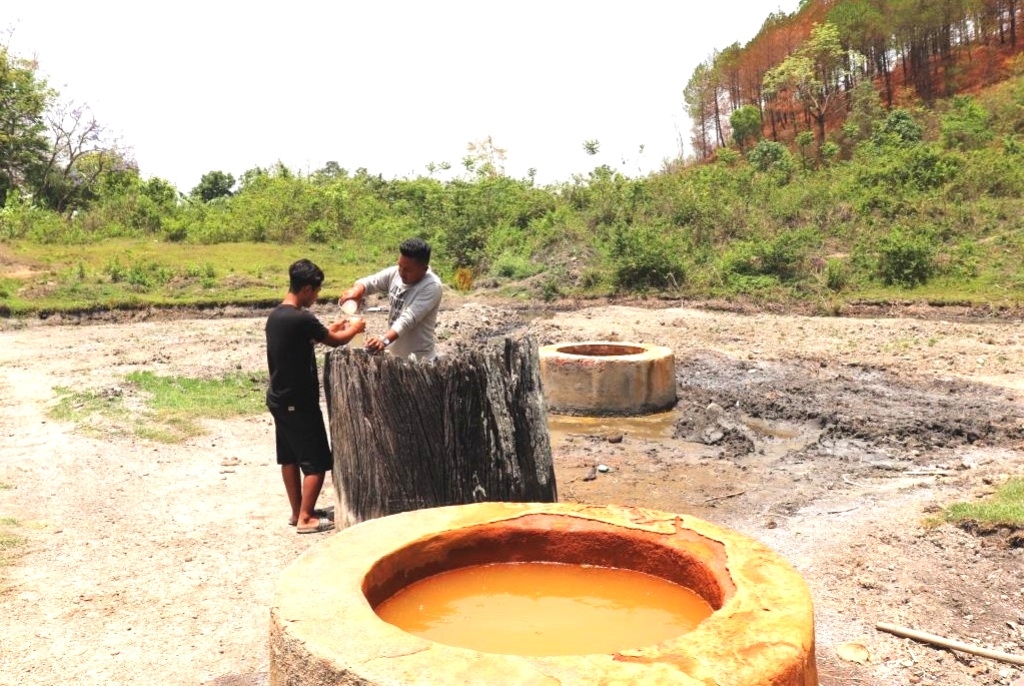
The present day kids might not have seen or even heard of Meitei salt (thum), but those 90’s children must have surely tasted it. To remind again that was so tantalisingly tasty and all have ate those salt cakes. Nowadays these are only used for ritual purposes and are available only at the local markets and Ningel village. It costs heavily nowadays and these are not as tasty as it used to be.
Historical records that of Hudson (1997) in the book “The Meithies” described that the Loi communities were assigned to work for the production of salt by the Kings of Manipur. The contextual specific connotation of the term Loi is found to be different from its historical specific connotation. Ningel is reported to be the only surviving village where the production of local salt-cake is still in practice to meet the domestic, religious and ceremonial needs of the people of Manipur. The record also highlighted the effect of the earthquake of January, 1869, and there had been to increase the yield of salt water in the well enormously; the water in the Ningel well after the earthquake rose six feet, and that rise had continued up to the present time undiminished. Sharma, (1991) in the Meitrabakki Khunthok Khundarol, Waikhong was considered to be one of the prime locations where salts were manufactured mainly for the royal family. The production of salt under the patron of the king in the Meiteileipak began during the reign of King Paikhomba (1666-97).
The scientific study of these salt brines was initiated by Geological Survey of India (GSI) during the 1960’s to 80’s. Waikhong, Shikhong, Chandrakhong, Phonjoukhong, Nongnaukunon, Ningel, Keithelmanbi, Chingai, Mariamphung, Namrei, Lachaikhulen, Kharasom, Thiwa and Sanakeithel village respectively are being reported by the workers of GSI. One peculiarity from the geological perspective is that these salt brines do occur along the piedmont hills bordering the eastern margin of the Imphal valley and in the shale units of the Disang Group. Many of these are seasonal and discharge varies. They have carried out preliminary researches about the salt quality and content, pressure & temperature, total dissolved solvents, X-ray analyses, etc.
Neither the traditional method of salt production nor the conventional scientific approaches to these salt brines are at present yielding better prospects. In the context a deep insight of the possibilities of high end products can be meaningful. So to cite many of the natural salt brines across the globe are extremely rich in high end mineral commodities like lithium and rare earth elements. Worldwide identified reserves in 2018 are estimated by the United States Geological Survey (USGS) to be 16 million tonnes. The world’s top 3 lithium-producing countries from 2016, as reported by the USGS are Australia, Chile and Argentina.
The last decade have experienced a pronounced inclination in the concept of energy production and utilization more towards solar energy than your hydro and thermal energy sources; lithium ion batteries instead of your acid based batteries. That’s why this year Nobel Prize for chemistry has been awarded to the team that conceptualized in their ideas for lithium ion batteries that run almost the entire electronic gadgets ranging from those nano chips to mobile and even the techno-fitted Artificial Intelligence (AI).
Viewing these trends and possible resources at Manipur, these traditional salt brines may be targeted for the Lithium reserves instead of running the unprofitable salt cake business. This does not imply to end the much heritaged tradition of salt cakes production rather it can go hand in hand with the search of Lithium sources. One more point to be focused is to target new possibilities of salt brines locations with proper scientific approach. This will eventually bring India particularly Manipur in the world map of Lithium production. A few investments in terms of new and prioritised investigation in these salt brines will be quite logical owing to today’s scientific approach. Let’s have the pristine taste of Meithei Thum as well as the potential of providing life to those AI’s, mobiles, e-gadgets from the soil of Manipur.




1 comment
A lot of thanks to the writer and Manipur Times